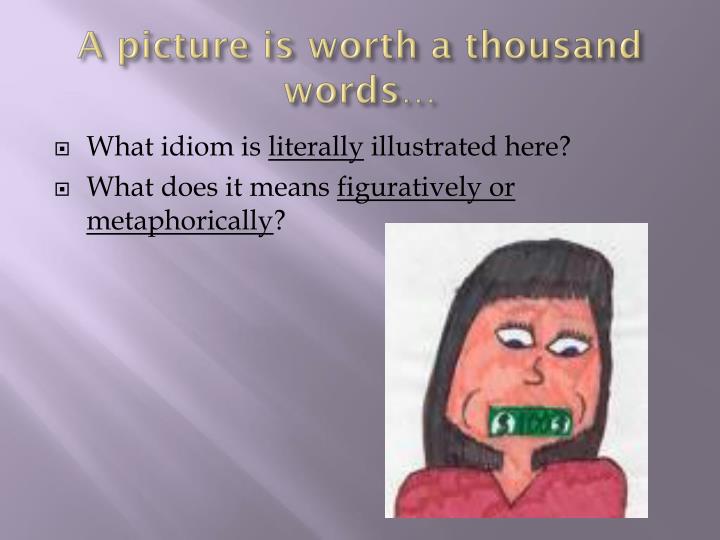
One could imagine the following interpretations: For example, the phrase " lend me your ear" could be analyzed in a number of ways. Sometimes, metaphor and metonymy may both be at work in the same figure of speech, or one could interpret a phrase metaphorically or metonymically. Thus, metaphor works by presenting a target set of meanings and using them to suggest a similarity between items, actions, or events in two domains, whereas metonymy calls up or references a specific domain (here, removing items from the sea). If someone is "fishing" for information, we do not imagine that the person is anywhere near the ocean rather, we transpose elements of the action of fishing (waiting, hoping to catch something that cannot be seen, probing) into a new domain (a conversation). In contrast, the metaphorical phrase "fishing for information" transfers the concept of fishing into a new domain.

What is carried across from "fishing fish" to "fishing pearls" is the domain of metonymy. The phrase "to fish pearls" uses metonymy, drawing from "fishing" the idea of taking things from the ocean. Two examples using the term "fishing" help clarify the distinction. Furthermore, the metaphor "magpie" is employed because, according to Zuckermann, hybridic "Israeli" displays the characteristics of a magpie, "stealing" from languages such as Arabic and English. The reason the metaphors "phoenix" and "cuckoo" are used is that on the one hand hybridic "Israeli" is based on Hebrew, which, like a phoenix, rises from the ashes and on the other hand, hybridic "Israeli" is based on Yiddish, which like a cuckoo, lays its egg in the nest of another bird, tricking it to believe that it is its own egg. : 4 There is no physical link between a language and a bird. On the other hand, when Ghil'ad Zuckermann argues that the Israeli language is a "phoenicuckoo cross with some magpie characteristics", he is definitely using metaphors. In other words, there is a pre-existent link between "crown" and "monarchy". The reason is that monarchs by and large indeed wear a crown, physically. However, in the phrase "lands belonging to the crown", the word "crown" is definitely a metonymy. Some uses of figurative language may be understood as both metonymy and metaphor for example, the relationship between "a crown" and a "king" could be interpreted metaphorically (i.e., the king, like his gold crown, could be seemingly stiff yet ultimately malleable, over-ornate, and consistently immobile). There is nothing press-like about reporters or crown-like about a monarch, but "the press" and "the crown" are both common metonyms. When people use metonymy, they do not typically wish to transfer qualities from one referent to another as they do with metaphor. Metonymy works by the contiguity (association) between two concepts, whereas the term "metaphor" is based upon their analogous similarity. Many cases of polysemy originate as metonyms: for example "chicken" meaning the meat as well as the animal "crown" for the object, as well as the institution. The figure of speech is a "metonymy of a metonymy".
LEND ME YOUR EARS SYNONYM DRIVER
For example, "lead foot" may describe a fast driver lead is heavy, and a heavy foot on the accelerator causes a vehicle to go fast. Metalepsis uses a familiar word or a phrase in a new context. Synecdoche uses a part to refer to the whole, or the whole to refer to the part. Greek and Latin scholars of rhetoric made significant contributions to the study of metonymy.

In addition to its use in everyday speech, metonymy is a figure of speech in some poetry and in much rhetoric. Whereas Roman Jakobson argued that the fundamental dichotomy in trope was between metaphor and metonymy, Burke argues that the fundamental dichotomy is between irony and synecdoche, which he also describes as the dichotomy between dialectic and representation, or again between reduction and perspective. He discusses them in particular ways in his book A Grammar of Motives.

Īmerican literary theorist Kenneth Burke considers metonymy as one of four "master tropes": metaphor, metonymy, synecdoche, and irony. In metaphor, this substitution is based on some specific analogy between two things, whereas in metonymy the substitution is based on some understood association or contiguity. Both metonymy and metaphor involve the substitution of one term for another. Polysemy, the capacity for a word or phrase to have multiple meanings, sometimes results from relations of metonymy. Synecdoche and metalepsis are considered specific types of metonymy. Metonymy and related figures of speech are common in everyday speech and writing. The words metonymy and metonym come from the Ancient Greek: μετωνυμία, metōnymía, "a change of name", from μετά, metá, "after, post, beyond", and -ωνυμία, -ōnymía, a suffix that names figures of speech, from ὄνυμα, ónyma or ὄνομα, ónoma, "name".


 0 kommentar(er)
0 kommentar(er)
